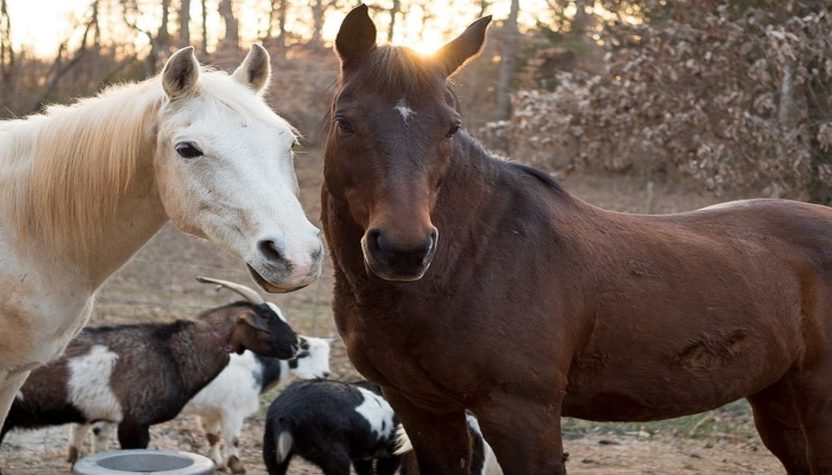I taught this lesson at a horse farm a couple summers ago. We conducted our art and writing summer camp there. Hands down, this was my favorite writing camp to date!
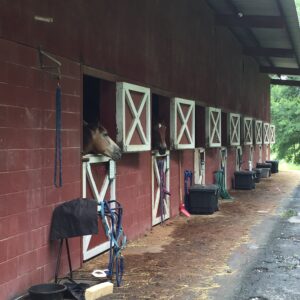

Book About Horses
The campers compiled a series of drawings and stories to form their own book about horses.

For one of the creative stories I guided the campers in writing an idiom story!
*This post contains affiliate links. For more information, see my disclosures here.*
Gimme Cracked Corn and I Will Share by Kevin O’Malley
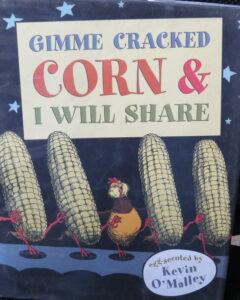
I got the idea for this lesson from the book, Gimme Cracked Corn and I Will Share by Kevin O’Malley. It’s an old book, but a very cute and clever one!
I highly recommend getting it on Amazon* if you want to do this lesson. Plus, it’s a fun read for any time!
In this particular book, the author uses idioms all about chickens and eggs throughout the story. I thought my own students would enjoy writing a farm story using farm animal idioms and they did!
NOW FOR THE LESSON!
To get a full understanding on how I conduct each writing lesson you may want to read the Writing Prompts Introduction post. The farm lesson outlined below (and all other prompts posted) will make more sense and be easier to follow and use.
Additionally, here’s the lined paper I use for Grades K-2 and Grades 2-7
Read the Book:
- First, read Gimme Cracked Corn and I will Share to the students. Point out the idioms.
Tell the Story Line
- Next, tell the story line: “You’re going to write a story about farm animals complaining to a horse. You’re going to use farm animal idioms in the story.”
- Then, explain to the students that idioms are phrases or sentences that represent a specific meaning and not the exact meaning of the words.
Brainstorm
- Third, give examples of farm animal idioms. It’s raining cats and dogs means “it’s raining really hard.” I gotta run means “I need to go now.”
- Brainstorm a list of common farm animal and horse idioms. Here’s a list of idioms to get you started.
- Also, brainstorm problems that the animals and horses might be having. For example, the farm animals:
- Are jealous of the attention the horses get.
- Think the horses are too loud or big.
- Can’t stand the horses smell.
Show the 5 Sections
-
- Introduce the problem
- Problem continues
- Farm animals gather
- Horse gets involved
- Problem solved
As mentioned in my writing prompts introduction: K-1st Graders are encouraged to write 1 sentence for each section, 2nd Graders 2 sentences, 3rd Graders 3 sentences and so on.
NOW TO WRITE!
Guide the students through the following steps so their story is organized and complete. They are free to write these ideas in their own words.
One camper wrote the following story. She is a bilingual Korean/English speaker (age 11) and did a marvelous job!
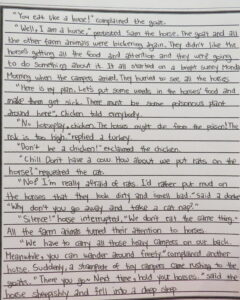
Argumentative Idiom to Start the Conversation
- On the first line, begin with a farm animal quoting an idiom to the horse. This quote should introduce the problem.
“You eat like a horse!” complained the goat.
“Will you please stop horsing around?! Clucked the chicken.
2. Second, write the horse’s response.
“Well, I am a horse,” protested Sam the horse.
“I was just reminding our keepers that it was breakfast time,” replied Star the horse.
The Problem Continues
3.Third, write about how the problem continues.
The goat and all the other animals were bickering again. They didn’t like the horses getting all the food and attention and they were going to do something about it. It all started on a bright sunny Monday morning when the campers arrived. Each camper hurried to see all the horses.
The Farm Animals Gather
4. Fourth, write about how the farm animals gather to discuss a solution.
“Here is my plan. Let’s put some weeds in the horses’ food and make them get sick. There must be some poisonous plant around here,” the chicken told everybody.
“No horseplay, chicken. The horses might die from the poison! The risk is too high,” replied the turkey.
“Don’t be a chicken!” exclaimed the chicken.
“Chill. Don’t have a cow. How about we put rats on the horse,” requested the cat.
“No! I’m really afraid of rats. I’d rather put mud on the horses so that they look dirty and smell bad,” said a donkey.
“Why don’t you go away and take a cat nap?” snapped the chicken.
The Horse Gets Involved
5. Fifth, write about how the horse gets involved.
“Silence!” the horse interrupted, “We don’t eat the same thing.” All the farm animals turned their attention to the horses.
The Problem Gets Solved
6. Lastly, write how the problem gets solved and the attitudes of the animals change.
“We have to carry all those heavy campers on our back. Meanwhile, you can wander around freely,” complained another horse. Suddenly, a stampede of tiny campers came rushing to the goats.
7. Finally, write any concluding thoughts, statements or actions.
“There you go. Next time, hold your horses,” said the horse sheepishly and fell into a deep sleep.
Print the Lesson
Here’s the full lesson for you to print out and use.
EASY ART ACCENTS
Try finding farm animal stickers* to put around the border. In addition, students can write the title at the top of the page using ABC stickers*.
GAMES TO PLAY!

Silly Sentences: (#2 of our Top 5 Writing Games) Use horse vocabulary in one circle.
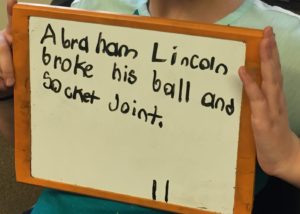
Smiley Face (using idioms)

